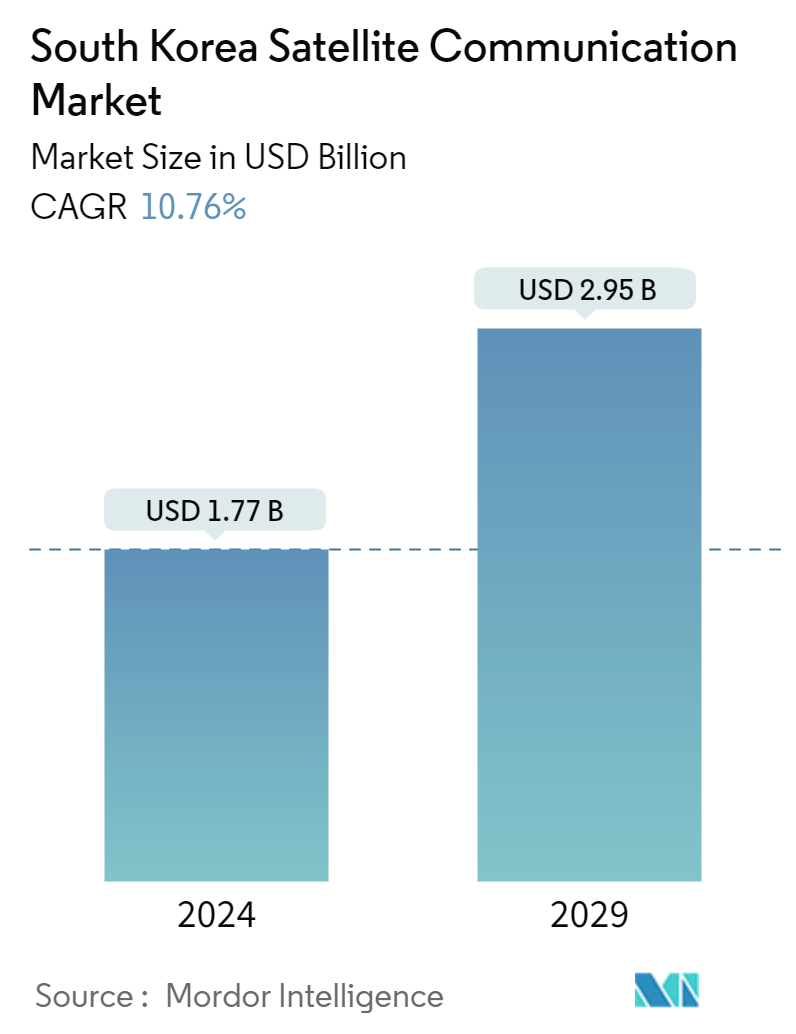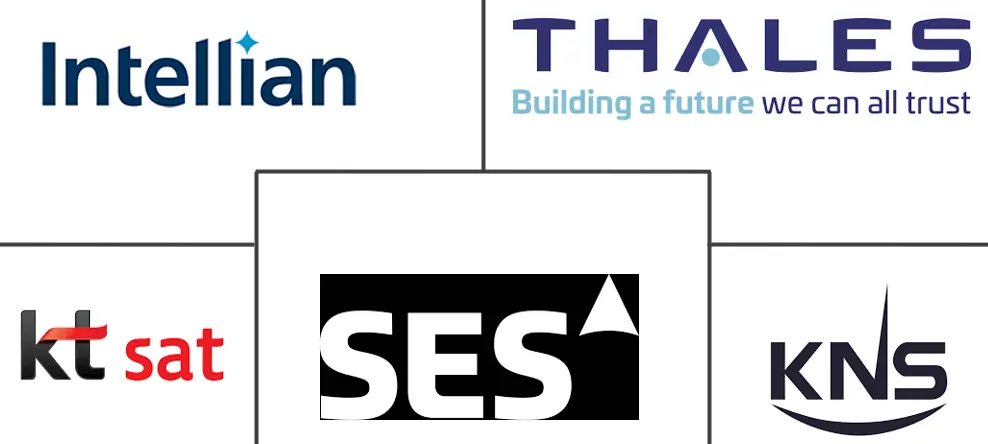Market Size of South Korea Satellite Communication Industry

| Study Period | 2019 - 2029 |
| Base Year For Estimation | 2023 |
| Market Size (2024) | USD 1.77 Billion |
| Market Size (2029) | USD 2.95 Billion |
| CAGR (2024 - 2029) | 10.76 % |
| Market Concentration | High |
Major Players
*Disclaimer: Major Players sorted in no particular order |
South Korea Satellite Communication Market Analysis
The South Korea Satellite Communication Market size is estimated at USD 1.77 billion in 2024, and is expected to reach USD 2.95 billion by 2029, growing at a CAGR of 10.76% during the forecast period (2024-2029).
The market's growth is attributed to the increased demand for broadband connectivity, the growing need for high-speed connections, government initiatives, and technological advancements.
- High-speed internet services are in greater demand in South Korea due to factors like remote work, e-learning, and rising usage of data-intensive applications. This trend has led to a greater reliance on satellite communication to provide connectivity in areas with limited terrestrial infrastructure, driving the growth of satellite broadband services. For instance, SK Broadband, Inc.'s revenue reached KRW 4.16 trillion in 2022 from KRW 4.05 trillion in 2021.
- The government has been actively supporting and promoting the satellite communication industry. It has launched various initiatives to foster innovation, research, and development in the space sector. These initiatives act as a growth driver for the satellite communication market in South Korea.
- In December 2022, the Ministry of Science and ICT signed a business cooperation agreement with the Defense Acquisition Program Administration (DAPA), the Agency for Defense Development (ADD), and the Institute for Information & Communication Technology Planning & Evaluation (IITP) to cooperate in developing satellite communication technology, securing orbit and frequencies for satellite communication networks, and establishing and demonstrating pilot networks.
- However, the limited satellite manufacturing capacity in South Korea is hampering the market growth. While the country has made several advancements in satellite technology, including developing and launching its satellites, the manufacturing capacity remains relatively limited. This constraint is leading to a dependency on international suppliers and potential delays in satellite deployments.
- With the growing demand for satellite communication services from different end-user verticals, several international players are expanding their service offerings in South Korea. For instance, in May 2022, the UK satellite company OneWeb planned to provide services for airlines and ships in South Korea, where its geographic conditions kept the existing technology from meeting demand from those clients.
South Korea Satellite Communication Industry Segmentation
Satellite communication is the transfer of data and information via satellites orbiting the Earth. It enables long-distance communication by relaying signals between ground stations and satellite receivers in orbit, enabling television broadcasts, internet access, and phone calls. The satellite communication (SATCOM) market is defined based on the revenues generated from the types used in various end-user verticals such as maritime, defense and government, enterprises, and media and entertainment. The analysis is based on the market insights captured through secondary research and the primaries. The report also covers the major factors impacting the market's growth in terms of drivers and restraints.
The scope of the study has been segmented based on the type of satellite communication equipment and services (ground equipment (a gateway, very small aperture terminal (VSAT) equipment, network operation center (NOC), and satellite newsgathering (SNG) equipment) and services (mobile satellite services (MSS), fixed satellite services, and earth observation services), platform (portable, land, maritime, and airborne), and end-user vertical (maritime, defense and government, enterprises, media and entertainment, and other end-user verticals). Common satellite communication services include voice calling and internet access for different applications. The report offers market forecasts and size in value (USD) for all the above segments.
The study tracks the key market parameters, underlying growth influencers, and major vendors operating in the industry, supporting the market estimations and growth rates over the forecast period. In addition, the study provides the SATCOM market trends, along with key vendor profiles. The study further analyzes the overall impact of COVID-19 on the ecosystem.
| By Type | |
| Ground Equipment | |
| Services |
| By Platform | |
| Portable | |
| Land | |
| Maritime | |
| Airborne |
| By End-user Vertical | |
| Maritime | |
| Defense and Government | |
| Enterprises | |
| Media and Entertainment | |
| Other End-user Verticals |
South Korea Satellite Communication Market Size Summary
The South Korean satellite communication market is poised for significant growth, driven by the increasing demand for high-speed broadband connectivity and government support for technological advancements in the space sector. The market is experiencing a surge in demand due to the rise of data-intensive applications such as remote work, e-learning, and online gaming, which necessitate reliable and fast internet access. The government's initiatives to foster innovation and development in satellite communication technology, along with strategic partnerships and agreements, are further propelling the market's expansion. However, challenges such as limited satellite manufacturing capacity in South Korea and dependency on international suppliers may impact the pace of growth.
The market landscape is characterized by the presence of major players, both national and international, who are actively expanding their service offerings and enhancing their capabilities to meet the growing demand. Companies like Intellian Technologies, KT Sat Co. Ltd, and Thales Group are leading the charge with strategic expansions and collaborations. The increasing penetration of online content streaming and the rise of satellite TV services are also contributing to the market's growth, as they offer comprehensive coverage and connectivity in areas with limited terrestrial infrastructure. As the demand for satellite communication services continues to rise, the market is expected to witness further consolidation and strategic initiatives aimed at enhancing competitive positioning and global presence.
South Korea Satellite Communication Market Size - Table of Contents
-
1. MARKET INSIGHTS
-
1.1 Market Overview
-
1.2 Industry Attractiveness - Porter's Five Forces Analysis
-
1.2.1 Bargaining Power of Buyers
-
1.2.2 Bargaining Power of Suppliers
-
1.2.3 Threat of New Entrants
-
1.2.4 Threat of Substitutes
-
1.2.5 Intensity of Competitive Rivalry
-
-
1.3 Industry Value Chain Analysis
-
1.4 Assessment of the Impact of COVID-19 on the Market
-
-
2. MARKET SEGMENTATION
-
2.1 By Type
-
2.1.1 Ground Equipment
-
2.1.2 Services
-
-
2.2 By Platform
-
2.2.1 Portable
-
2.2.2 Land
-
2.2.3 Maritime
-
2.2.4 Airborne
-
-
2.3 By End-user Vertical
-
2.3.1 Maritime
-
2.3.2 Defense and Government
-
2.3.3 Enterprises
-
2.3.4 Media and Entertainment
-
2.3.5 Other End-user Verticals
-
-
South Korea Satellite Communication Market Size FAQs
How big is the South Korea Satellite Communication Market?
The South Korea Satellite Communication Market size is expected to reach USD 1.77 billion in 2024 and grow at a CAGR of 10.76% to reach USD 2.95 billion by 2029.
What is the current South Korea Satellite Communication Market size?
In 2024, the South Korea Satellite Communication Market size is expected to reach USD 1.77 billion.

